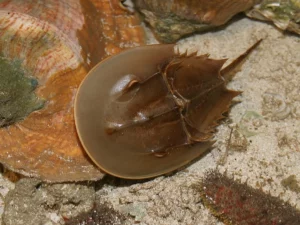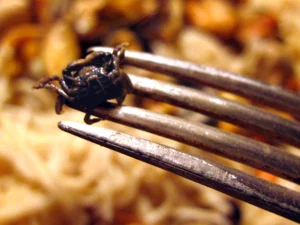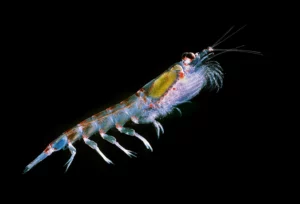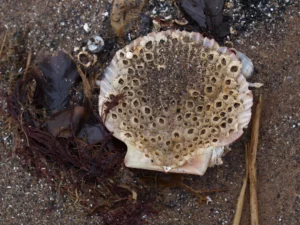Crustaceans are invertebrate animals that possess a segmented body with a rigid other part which is called the exoskeleton. Let us explore some examples of crustacean below.
- American Lobster
- Horseshoe Crab
- Pistol Shrimp
- Hermit Crab
- Whale Lice
- Remipedes
- Japanese Spider Crab
- Pea Crab
- Woodlouse
- Crayfish
- Krill
- Slipper Lobster
- Tadpole Shrimp
- Sea Spider
- Barnacle
- Water Fleas
- Common Yabby
American Lobster
American lobster can be identified for its large circular claws (aid in crushing the prey, holding and tearing it). The major sensory element is the antenna which aids in the smell recognition. The lifespan is approximately up to 100 to 140 years. American lobsters feed on dead animals (seafloor) and marine creatures.
HorseShoe Crab
Horseshoe Crab is considered as a prehistoric animal and also as living fossils. They possess a round body and it resembles the shape of a horse shoe. Horseshoe crabs are considered edible in few parts of the world, application as fertilizer or even bait.

Image Credits: Wikimedia
Pistol Shrimp
Pistol Shrimp are also called snapping shrimp. They are mostly carnivores or even omnivores. The lifespan of pistol shrimp is up to 4 years and they appear in many color variations like red, brown, green, white and a lot more.
Hermit Crab
Hermit crabs carry their home with them. Yes, they carry the shell which is like their home. The unique feature of this crustacean is that they do not possess the rigid or hard shell outside their structure. It is reported that approximately 1100 species of hermit crabs are found worldwide.

Image credits: Wikimedia
Whale Lice
Whale Lice are usually flat in shape and have a reduced rear. They have 3 pairs of legs at the back which resemble a claw. They are approximately 5 to 25 millimeters (0.2 to 1 inch) based on their species.
Remipedes
Remipedes is like a worm which falls under the crustaceans family. They do not possess any color or eyes and they grow upto 45mm long. The head of remipedes possess a filament-like structure of sensory element and the mouth is seen inside the head portion.
Japanese Spider Crab
Japanese Spider Crab got its name as it resembles a spider but it has around 10 limbs. It is considered one of the largest arthropods as it grows to a max of 12 ft. The males are generally bigger than the females in Japanese Spider Crab.
Pea Crab
Pea Crab is a significant type of crustaceans as they are considered the tiniest crab species among all. The name “Pea” is referred as very small and this is why it has got the name as pea crab. The shell is yellowish gray with brown spots.

Image Credits: Wikimedia
Woodlouse
Woodlouse is usually a herbivorous organism which is seen in brown, gray and black color. The lifespan is about 3 to 4 years and they weigh less than 1 gram. They grow up to 0.7mm to 18mm and they are prevalent worldwide except Antarctica.
Crayfish
Crayfish, also known as crawfish, is a freshwater crustacean. They appear in green or sandy color which grows upto 7.5 cm to 15 cm in length. The other names of crayfish are crodgers, crawdads. Crayfish are considered edible in China, Africa, Australia.
Krill
Krill has about 85 species. They are small creatures yet they play a main role in the food chain process as many higher species feed on them. Krill can grow up to 4.5 cm and weigh about 2 grams. Krill are found in the marine ecosystem.

Image Credits: Wikimedia
Slipper Lobster
Slipper Lobsters are also known as Bulldozer lobster, Shovel-nosed lobster, and Sand lobster. The size depends on the species but collectively they range between 5 to 50 cm. The life span is up to 15 years. They are brown or reddish brown in color.
Tadpole Shrimp
Tadpole Shrimp is one of the most commonly found crustaceans worldwide. Tadpole Shrimp are found only in freshwater which are not so deep (30-60 feet long with a depth of about 4). The most found tadpole shrimp species is “Triops longicaudatus”. Tadpole shrimps are omnivorous.
Sea Spider
Sea spider has long legs and a tiny body. Sea spider has about 4 to 6 pairs of legs. The fascinating part of sea spiders is that they lack a respiratory system and instead use their legs for gaseous exchange. They feed on coral reefs and aquatic worms.
Barnacle
Barnacles are seen in marine habitats and found worldwide. They feed on plankton and other dead organic material in the shallow sea bed. The commonly found Barnacle is Acorn Barnacle, which does not have any stalks in them.

Image Credits: Wikimedia
Water Fleas
Water Fleas are present worldwide and are about 450 species. Few are found in freshwater habitats and few in marine ones. They grow to a size of 0.2 to 3.0 millimeters. Water fleas are mostly eaten by the fishes.
Common Yabby
Common Yabbies are seen in freshwater habitats and they feed on algae, other dead matter. The native of Common Yabby is Southern Australia but is also seen in Spain, Italy, China, Netherlands and many more places.
Conclusion:
This article comprises a list of around 17 examples of crustaceans and their features like habitats, size, shape, color and body structure (morphology). The article also gives a deep layout about specific facts of each crustacean species.
Read more about Mantis Shrimp.
Also Read:
- Polyunsaturated fatty acids examples
- Adenine vs thymine
- Is enzyme a catalyst
- Do chloroplasts have enzymes
- Do humans have plant cells
- Foot anatomy
- Meiosis stages 2
- Parasitic plant example
- Bamboo tree
- Protein denaturation process

Hello, I am Sugaprabha Prasath, a Postgraduate in the field of Microbiology. I am an active member of the Indian association of applied microbiology (IAAM). I have research experience in preclinical (Zebrafish), bacterial enzymology, and nanotechnology. I have published 2 research articles in an International journal and a few more are yet to be published, 2 sequences were submitted to NCBI-GENBANK. I am good at clearly explaining the concepts in biology at both basic and advanced levels. My area of specialization is biotechnology, microbiology, enzymology, molecular biology, and pharmacovigilance. Apart from academics, I love gardening and being with plants and animals.
My LinkedIn profile-